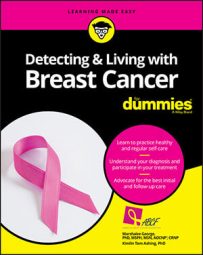Some basic medical terminology
As you read the biopsy results, you are likely to come across some unfamiliar terminology. Here are a few of the more common terms and their definitions:- Atypical: Abnormal/unusual, but not cancerous. However, surgery is recommended for atypical lesions found on core biopsy.
- Benign: Noncancerous and unlikely to spread.
- Carcinoma: Cancer that started with cells that line organs, called epithelial cells. This can be invasive or infiltrating or in situ (see upcoming definition).
- Hyperplasia: More cells than normal in a tissue sample. There are several types of hyperplasia:
-
- Usual ductal hyperplasia (UDH): The pattern of cells is very close to that of normal cells.
- Atypical ductal hyperplasia (ADH): The presence of more cells than normal and cells with an unusual appearance in the lining of the ducts.
-
- Atypical lobular hyperplasia (ALH): The presence of more cells than normal and cells with an unusual appearance in the lobules (lobes of glandular tissue in the breast are further subdivided into lobules that produce milk).
- In situ: Latin for "in place," meaning the cancer has not spread. There are two types of in situ:
- Ductal carcinoma in situ (DCIS): This is a breast cancer. (Read more about DCIS in the section "Most common types of breast cancer.")
- Lobular carcinoma in situ (LCIS): This is not cancer. It is formed from abnormal cells in the lobules or milk ducts of the breast. When you're diagnosed with LCIS, however, you are at an increased risk for developing breast cancer in the future.
- Invasive or infiltrating: Cancer has spread or is likely to spread from its site of origin to nearby tissue.
- Malignant: Cancerous, has or is likely to spread.
- Negative: Is absent (not present).
- Neoplasia: Uncontrolled cell growth, may be benign or cancerous.
- Noninvasive: Cancer has not spread at this time.
- Positive: Is present.
- Sarcoma: Cancer that started with cells that don't line organs, called parenchymal cells.
The nuances of "abnormal"
Instead of negative and positive, some reports use normal and abnormal to indicate the condition of the cells that the pathologist examined. As you might expect, normal is all good — the tissue that was biopsied is normal tissue with no sign of cancer. Abnormal means that the cells are unusual (atypical) but they may be cancerous or noncancerous.If your report shows that a tissue sample was abnormal without cancerous cells, you may have a benign tumor or some other tissue abnormality, such as one of the following:
- Atypical ductal hyperplasia (ADH): Having ADH increases your risk of developing breast cancer in the future, but these cells are not cancerous themselves.
- Atypical lobular hyperplasia (ALH): Having ALH increases your risk of developing breast cancer in the future, but these cells themselves are not cancerous.
- Breast cyst: Fluid-filled sac located inside the breast that is usually benign (not cancerous). You can have one or many breast cysts, and they can happen in one or both breasts. They can feel like a grape or fluid-filled balloon and may be tender at times.
- Calcifications: Very small calcium deposits that can develop in the breast tissue. They can appear like white dots or flecks on the mammogram image but can't be felt during a breast exam. Breast calcifications can have varying diagnosis. Some calcifications can be diagnosed as benign, DCIS, or IDC (read more about IDC in the section "Most common types of breast cancer").
- Fibroadenoma: Fibrous and glandular breast tissue. These often feel like smooth, rubbery lumps that may be painful.
- Intraductal papilloma: Wart-like growth in the milk duct of the breast usually close to the nipple, which may cause pain and nipple discharge.
- Lobular carcinoma in situ (LCIS): Having LCIS increases the risk of developing breast cancer (specifically DCIS or IDC) in the future.
- Radial scar, or complex sclerosing lesion: This is not a scar. It is an area of the breast tissue that has hardened. It's not felt but is often only found on a routine mammogram or during evaluation of breast symptoms.

